Samsung LE55A956 55in LCD TV Review
Samsung LE55A956 55in LCD TV
Samsung combines LED backlighting and a range of nifty features with great effect in this big 55in LCD TV.
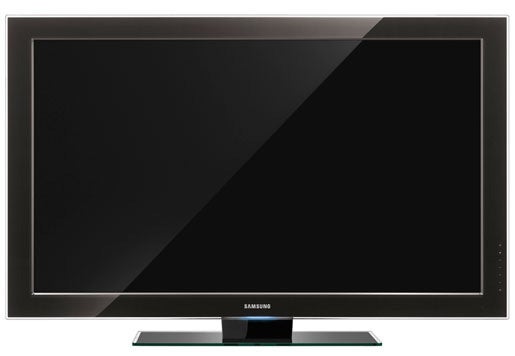
Verdict
Key Specifications
- Review Price: £2274.70
Way back last December we checked out the UK’s first ever LCD TV to use LED backlighting, Samsung’s LE52F96BD. The set was expensive, and definitely had one or two picture flaws to worry about. But its portrayal of colour and especially black level revolutionised in an instant our expectations of what LCD TVs might be capable of. So much so that we suggested that we left it convinced that one day all flat TVs might be made using LED backlighting. Predictably, since then we’ve seen neither hide nor hair of another LED TV. Doh.
Thankfully for our reputation as technological soothsayers, though, LED is not only finally back on the TV scene, but it appears to be at the very centre of the current TV strategies of a whole host of manufacturers. Philips, Sony, and Sharp all have LED TVs due to arrive in the UK any moment now, for instance. But first of the new LED TV breed to find its way onto our test benches comes from Samsung again, in the gorgeous and huge form of the 55in LE55A956: the flagship model of Samsung’s current flat TV range.
Will this monster screen live up to the hype and deliver the quantum leap in LCD performance standards that we’ve been longing for?
If aesthetics were a guarantee of inner quality, we could pack up this review and go home now. For in typical Samsung fashion, the LE55A956 is one heck of a looker. It continues Samsung’s current ‘touch of colour’ theme, only this time instead of the touch of red we’ve become used to, we get a hint of charcoal grey. And a very attractive hint it is too.
As if this wasn’t enough, the LE55A956 also boasts a cute honeycomb effect in its bezel that subtly becomes visible in bright light, while a glass top-sheet gives the whole thing a luxuriously shiny finish. All in all, the LE55A956’s appearance is perfectly suited to its flagship status.
As we’re coming to expect from Samsung, its new LED set is superbly stocked with connections, too. Four v1.3 HDMIs set a great early pace, and these are joined by such other highlights as a component video input, a dedicated analogue PC input and, significantly, USB 2.0 and Ethernet ports.
These latter two jacks are key to another innovation of the LE55A956: its multimedia savviness. The USB 2.0 port, for instance, can play a variety of movie file formats as well as the more typical MP3 and JPEG files. And the Ethernet port (which is fully DLNA specified) both enables you to connect the TV to your PC network so you an play files stored on your computer, and lets you connect the LE55A956 to a broadband Internet connection.
Why have a broadband connection? Because of the set’s InfoLive feature, where you can download a selection of information services specially formatted for the TV via a deal with Yahoo.
We won’t go into full detail on the sort of services made possible by the InfoLive system here, as we covered them in our review of Samsung’s PS50A756 plasma TV at the weekend. But briefly, you can get regularly updated news stories, weather reports (specific to your area, if you wish) and nearly-live stocks and share figures piped straight onto your screen at the press of a button.
We must stress, too, that you don’t actually have to hard-wire the LE55A956 to your broadband pipe. For an optional dongle Samsung makes for the TV’s USB port enables you to connect the TV to your wireless router if you have one.
As we noted in our review of the PS50A756, getting the wireless system working was a bit of a pain during our tests, and ultimately involved the unsecure practice of deactivating PING blocking on our router for a short time before we could get the TV talking to its remote information host. But when you finally do get it working, InfoLive certainly feels like a cool if currently limited expansion of what you’d normally expect a TV to do.
Another form of interactivity the LE55A956 shares with the PS50A756 is its Content Library. Again we won’t repeat the weekend’s review by going into detail about this feature here, but briefly speaking the Content Library comprises a selection of materials built-in the TV’s memory banks, ranging from photos and paintings through to recipes, exercise routines and children’s stories and games.
Aside from the excellent collection of pictures to help convert the TV into a picture frame when you’re not using it as a telly, it’s hard to tell how much most people will use the rest of the content Samsung has provided. But it’s certainly an interesting glimpse of the sort of thing we might start to see regularly on future TVs, and certainly beats the credit crunch as a topic of after-dinner conversation.
Other features of note on the LE55A956 include: 100Hz MotionPlus, which doubles the PAL frame rate and interpolates new intermediate image frames to improve the clarity and smoothness of motion; a black level booster; backlight adjustment; a dynamic contrast feature; flesh tone adjustment; edge enhancement; digital noise reduction; and something called Smart LED.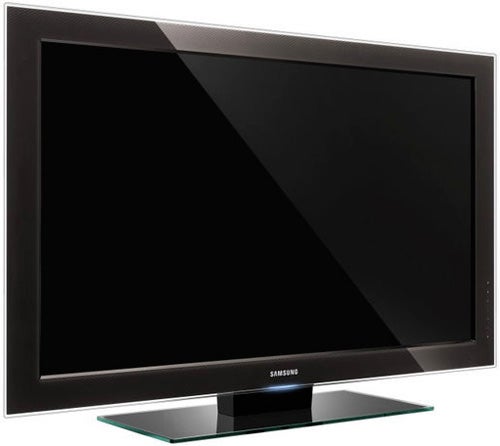
Ah yes, LED – that killer feature of the LE55A956 we seem to have forgotten about since the start of this review. Activating the Smart LED feature is pretty much essential, if you ask me, for it introduces LED’s strongest advantage: the fact that separate parts of the LED backlight array can be dimmed or even switched off independently of each other, with a potentially dramatic impact on black level response versus standard LCD TVs, which use a single, always-on backlight.
For instance, if some parts of a picture are dark and others bright, the LE55A956 can dim the elements of its LED array that are supposed to be showing dark colours without also dimming the bright parts of the picture. Whereas with standard LCD TVs, if you dim the output of the single backlight to improve dark picture areas, the bright picture areas look dimmer too.
To reinforce just how important this difference is, Samsung claims a contrast ratio figure for the LE55A956 of – cue fanfare – 2,000,000:1. This, my friends, is double that quoted even by Panasonic and Pioneer’s latest plasma TVs. Pretty exciting, huh? Well yes, but we should point out that the LED backlight system does make it possible for Samsung – and other LED makers – to play the numbers game even more ‘optimistically’ than usual. For you can, after all, turn a section of the LED array off completely to deliver total darkness at the same time that another part of the array is running at full power. And it’s most likely in these circumstances – which will, of course, almost certainly never be reproduced during normal TV viewing – that the two million to one figure was recorded.
That said, it’s apparent very quickly from watching the LE55A956 in action that there really is something quite special going on with the set’s contrast. Skipping straight to the sword fight in the treasure cave between Barbossa and Captain Sparrow in the first ”Pirates of the Caribbean” on Blu-ray, for instance, finds some remarkably deep black levels sitting right alongside exceptionally bright, vibrant colours and dynamic peak whites.
Actually, although I’m conscious that I seem to be using a lot of hyperbole in my latest two or three reviews, I really have no option but to say that the LE55A956 delivers the single most dynamic picture we’ve ever seen on a flat TV.
For while standard LCD TVs can do ultra-vivid colours and extreme brightness, they can’t deliver that alongside deep, deep black levels. And while the best plasma TVs can do extreme black levels, their pictures aren’t as bright as those of LCD. On the evidence of the LE55A956, as we’d hoped from the early promise of last year’s LE52F96, LED really can put ultra-bright next to ultra-dark in a way not previously seen outside of a cinema. And the effect is stunning.
Another benefit of LED technology is its potential for delivering a wider colourscape. And here too the LE55A956 delivers on its promise, as the colour range on show from the excellent ”Pirates” Blu-ray is intense, dynamic, and just somehow more expressive than we’re used to seeing it.
Indeed, initially I felt that colours were a little too rich, that they started to look slightly unnatural. But happily, adjusting the set’s Colour Space to Auto or Custom away from the Native factory preset (which seems to expand a source’s colours to fill the full gamut possible from the LED system) soon sorted that out, leaving me staring agog at probably the most colour-rich, punchy image I’ve seen in a testing environment.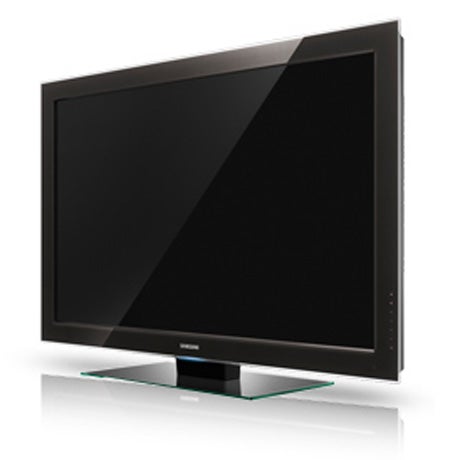
For a while I still occasionally felt that one or two colours looked slightly wrong. But after a little judicious tweaking of the colour settings via the LE55A956’s impressive suite of colour adjustments I sorted nearly everything out to my satisfaction.
Another benefit of LED backlit TVs I’ve not mentioned yet is their potential for portraying motion more successfully than standard LCDs, since the ability to activate areas of luminance in the picture on an individual basis has the potential to reduce the ‘step and hold’ effect that blights motion on normal, single-backlight LCD TVs. And here again the LE55A956 doesn’t let us down.
The various fights at the beginning of ”Batman Begins” on Blu-ray take place on the Samsung with scarcely a trace of the blurring or stuttering effects witnessed on so many ordinary LCD TVs – especially if you call in the 100Hz engine to further help out the screen’s motion handling.
The relative clarity enjoyed by motion on the LE55A956 is backed up in emphatic fashion by the amount of noise-free detailing in its HD presentation, as the inevitable Full HD resolution joins forces with the clear motion and extreme screen size to do a jaw-dropping job of bringing out every last pixel of detail from the superbly coded ”Batman Begins” Blu-ray.
It is possible to damage the LE55A956’s generally outstanding HD performance if you’re not careful with some of the TV’s settings. For instance, the Edge Enhancement tool causes edges to look over-stressed; the 100Hz MotionPlus engine can cause flickering and twitching interference if you set it higher than its Low level; and the digital noise reduction tool can soften pictures up – something you really don’t want to happen with HD.
For all its truly groundbreaking capabilities, though, the LE55A956 isn’t perfect. Without doubt the biggest problem is its extremely limited viewing angle. As soon as you get to a viewing angle of around 40 degrees you can see some really quite extreme ‘blooming’, for want of a better word, around bright parts of the picture, especially when showing extreme contrasts.
Actually, on rare occasions there is a little blooming around bright parts of pictures even when you’re looking straight at the TV. This was a much bigger problem on last year’s Samsung LED TV, though, and the extent of the improvement is considerable. So much so that it really is barely a problem at all on the LE55A956 – provided you can look at the TV from pretty much straight on.
Another potentially serious issue with the LE55A956 is that the dynamic LED backlight system seems to cause quite a bit of lag between a source picture entering the TV and it appearing onscreen.
For instance, while trying to play Star Wars: The Force Unleashed on my trusty Xbox 360, I felt as if I just wasn’t performing to my usual standards during the game’s frequent boss battles. I just didn’t seem able to dodge attacks as fluently as expected. Switching back to a reference Pioneer plasma found my performance returning to normal. So I went back to the LE55A956 and the problem was confirmed; namely that while I was reacting normally to what I was seeing on screen, what I was seeing was actually slightly behind what the console was ‘seeing’.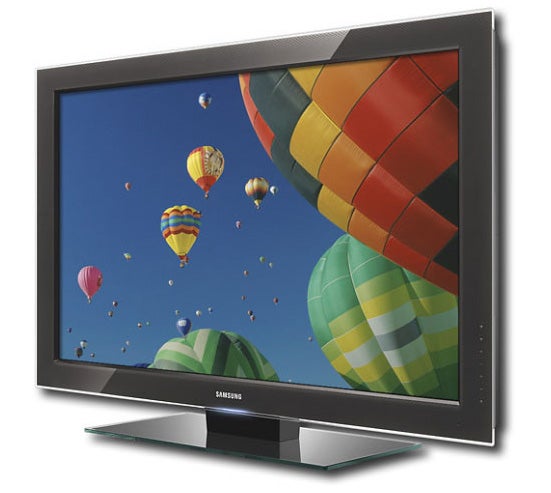
Luckily I didn’t find this lag issue so severe that it caused any lip-synch problems while watching video, so it doesn’t diminish the LE55A956’s potential as a home cinema screen. But hardcore gamers will certainly not be happy about having their performance potentially damaged by the LE55A956’s machinations.
I also found the LE55A956’s screen reflecting ambient light from my test room a little more obviously than I would ideally have liked; dark areas of the picture occasionally looking fractionally green even after colour tweaking; occasional evidence of minor colour banding; and upscaling of standard definition sources that can only be considered solid rather than inspiring.
Turning to the LE55A956’s audio, we should start by saying that we’ve been pretty underwhelmed by the audio efforts of most of Samsung’s recent TVs. But thankfully this flagship model exhibits considerably more power and dynamic range in the soundstage than its cheaper siblings, so that it provides a fittingly potent partner for the huge and dynamic pictures.
Let’s not forget, either, that while the LE55A956 might be expensive by normal LCD standards, it actually seems pretty cheap by LED standards given the sort of prices we’ve heard for upcoming LED models from other brands. Sharp’s 52in LC-52XS1E, for instance, is set to retail for around £8,000.
”’Verdict”’
While its various little picture niggles open the door for other upcoming LED models to potentially outperform the LE55A956, right now the problems don’t do enough to stop me feeling as if I’ve just spent quality time with not only a great picture performance, but a picture performance that could well be at the vanguard of a whole new level of quality coming our way as LED becomes more commonplace.
So if you want a truly huge screen delivering mesmerising LED picture quality, not to mention online interactive features and all manner of multimedia support, but you don’t want to spend the earth, the LE55A956 has got to be worth very serious consideration indeed.
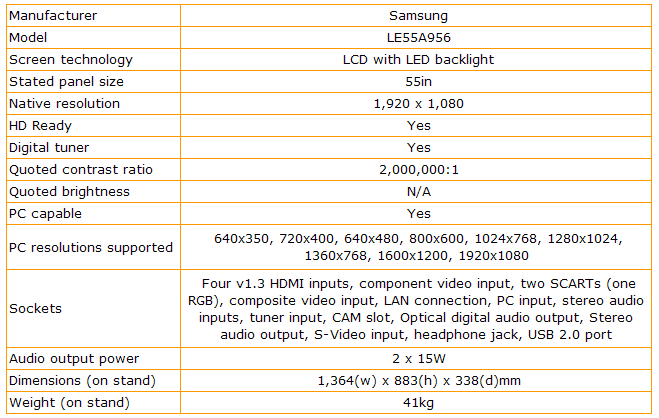
How we test televisions
We test every TV we review thoroughly over an extended period of time. We use industry standard tests to compare features properly. We’ll always tell you what we find. We never, ever, accept money to review a product.
Trusted Score
Score in detail
-
Features 10
-
Value 8
-
Image Quality 9
-
Design 10
-
Sound Quality 9

